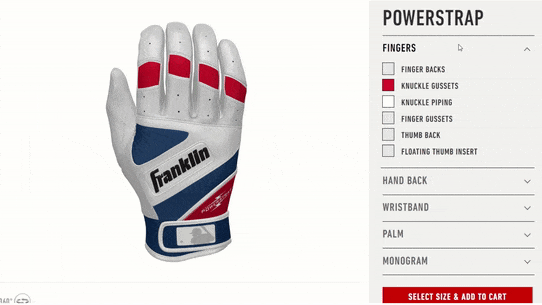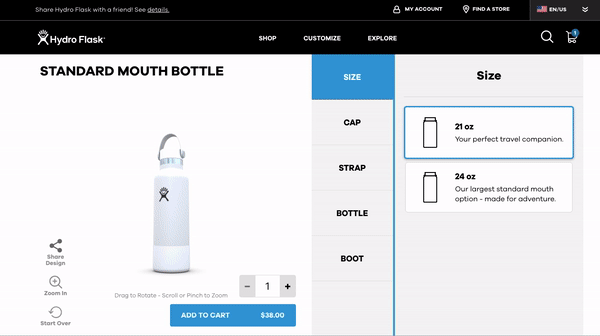
In the world of ecommerce, photorealistic visualization is a hot topic. What exactly does photorealistic visualization mean – and do you need it for your website? Read on to learn more.
Photorealistic visualization is a type of 3D rendering where the final results can't be distinguished from a photograph. When applied to ecommerce, it means the computer-generated 3D model looks just like the real product.
The term "photorealism" has its origins in the world of art. Photorealistic artists specialize in paintings that portray their subjects in a hyper-realistic fashion. This requires a mastery of detail, lighting, and other techniques to create paintings that are indistinguishable from photographs.
Photorealistic visualization, sometimes called photorealistic rendering, takes the same approach but with computer-generated images. Instead of displaying a flat photograph of an object, photorealistic visualization creates a 3D rendering of the subject in three dimensions that can be rotated and zoomed in on. This allows the customer to see it from all possible sides and angles, just like in a physical store. A successful photorealistic visualization looks like a real-world model of the subject.
These photorealistic renderings are used in a variety of circumstances, from ecommerce websites where they display clothing, furniture, or other products for sale, to real estate and architectural firms, where they're used to build realistic models of buildings before a single brick has been laid. Some photorealistic visualization software enables the rendered product to be customized in real time so users can see their desired product variations before they buy.
Many photorealistic visualizations today are created using a web standard called WebGL. Photorealistic rendering software, such as that from ConfigureID, utilizes the WebGL engine to deliver highly realistic 3D images through Google Chrome and any other web browser.
WebGL is a cross-platform web standard that includes a modeling tool and library designers and companies like ConfigureID use to render detailed 3D imagery. Designers work with your content to create a 3D canvas for your product. WebGL then renders interactive 3D images based on relevant data inputted by the designer – dimensions, materials, textures, and the like.
Once you create the photorealistic 3D model, shoppers can interact with it in several ways, including modifying the product and seeing those changes in real time. You can add controls that let customers create their own fully-rendered customized versions of a product.
Photorealistic visualization is useful for almost any situation where highly detailed product imagery is required. Some of the most popular uses of this hyper-realistic 3D rendering technology include:
Many companies offer products that can be customized or personalized in various ways. A product customization tool can build on the photorealistic model and enable customers to choose from a variety of options – colors, sizes, fabrics, accessories, and more. As the customer selects each option the rendering updates in real time, creating a virtual product that helps build confidence in the customer's selections.
Many clothing products and accessories can be personalized by adding a name, monogram, or other text to the item. By using photorealistic rendering, the chosen text can be added to the product imagery in the selected size, font, and color, so the customer can see how it looks before placing the order.
Other clothing products, such as t-shirts, can be personalized with images uploaded by customers or selected from a clip-art library. Photorealistic visualization can easily add these customer-supplied images to the original product renderings, displaying the custom product onscreen.
Many retailers like to bundle two or more products together or encourage add-on sales of accessories and other items. By using photorealistic visualization you can show what different products look like together, just like in a physical store.
Architects use photorealistic visualization to create life-like 3D walkthroughs of projects they're designing. Photorealistic renderings enable interested parties to virtually "walk" through structures still in the design phase to get a sense of how the building will look and make suggestions for desired alterations. You can also use virtual walkthroughs in the real estate industry to provide an immersive sales experience without having to physically visit the building for sale.
There are many ways retail brands can incorporate photorealistic visualization into their ecommerce strategies. Some of our favorites include:
Fender offers a wide range of electric guitars, acoustic guitars, basses, accessories, and more for guitar lovers around the world. The brand’s Mod Shop allows customers to customize 8 guitar models to match their personal style to a T. Online shoppers can choose from a variety of body colors, neck shapes, pickups, tuning machines, strings, and much more. The photorealistic 3D models of the customizable guitars are all powered by ConfigureID and our cutting-edge WebGL technology.
Via Fender
Franklin Sports offers a large selection of batting gloves and other sports gear for baseball and sports fanatics. The brand’s custom shop allows customers to customize around 20 different areas of the gloves to create a pair unique to them or their team. Shoppers can see how each of their selections looks on the photorealistic model of the batting glove in real time, helping increase conversion rates and brand loyalty. Franklin Sports is another great example of a ConfigureID customer reaping the benefits of photorealistic 3D product visualization with WebGL.

Via Franklin Sports
Hydro Flask is one of the most popular water bottle brands around. One of its key differentiators is the My Hydro online product customization experience. It allows shoppers to select from a range of bold colors for the cap, strap, bottle, and boot areas as well as add a personalized name, monogram, or short message. Recently launched in 3D using WebGL technology (with the help of ConfigureID), Hydro Flask fanatics can now visualize their unique creations in photorealistic detail from all angles.

Via Hydro Flask
If your company engages in ecommerce, photorealistic visualization can help you sell more products to more customers. Photorealistic product renderings bring online shopping much closer to the in-store experience. Combined with product personalization, this typically results in increased conversions, margins, and revenue for your brand.
Here are eight important reasons why you need to incorporate photorealistic visualization in your ecommerce website.
Photorealistic product visualization can help your brand:
Being able to see photorealistic renderings of products creates a more immersive and engaging shopping experience for customers. Viewing a static product photo pales in comparison to rotating and zooming in on a 3D virtual product model. High-quality 3D models also allow you to offer product customization more easily, which greatly contributes to increased shopper engagement. Finally, it gives customers the confidence they'll like the products they order since they've already seen them from all angles.
We're living in the age of mass customization. Customers expect to be able to personalize the products they buy – not just the size and color, but also materials, add-ons, and accessories. By incorporating photorealistic visualization in a 3D product configurator, customers can personalize your products to their heart’s content. It puts the customer in total control of the customization process.
If you can offer the personalized photorealistic shopping experience that your competition doesn't, you gain a huge competitive advantage. The more you can personalize the shopping experience, the more you differentiate your products and your company from the competition.
Personalized photorealistic product renderings will attract new customers seeking a better and more unique shopping experience. When shoppers discover that you provide a more engaging experience that they can't get elsewhere, you'll see website traffic start to jump.
Studies show that employing photorealistic 3D product imagery can increase conversion rates by up to 40%. Potential customers become real customers when they're confident in what they purchase – and seeing customized products in near real-life detail before they buy provides that confidence.
Not only does offering personalized photorealistic shopping increase conversion rates, it also increases the average value of each order. A recent survey found that almost half (49%) of customers shopping in a personalized environment made impulse purchases in addition to their main purchase.
Because photorealistic visualization enables customers to purchase with confidence, your returns rate is likely to go down dramatically. Customers no longer have to purchase multiple sizes of the same item, only to return the ones that don't fit. Nor are they likely to return items that don't look the same in person as they did online. Photorealistic product rendering shows customers exactly what they'll get so they're less likely to return the items they buy.
All of these factors, from increasing conversions to lowering returns, work to increase your company's product margins. Research from Deloitte and Touch found that businesses that offered a customer-centric experience were 60% more profitable than those that didn't focus on the customer. That's significant.
Photorealistic visualization and product personalization might sound complicated, but the experts at ConfigureID can make it easy for you. We have more than fifteen years of experience helping companies like yours drive sales with premium product personalization solutions. Every year, our solutions inspire customers to explore more than 730 million product personalization options and add more than 5 million personalized products to their shopping carts.
Contact us today for a free demo of ConfigureID’s photorealistic product visualization and personalization platform!